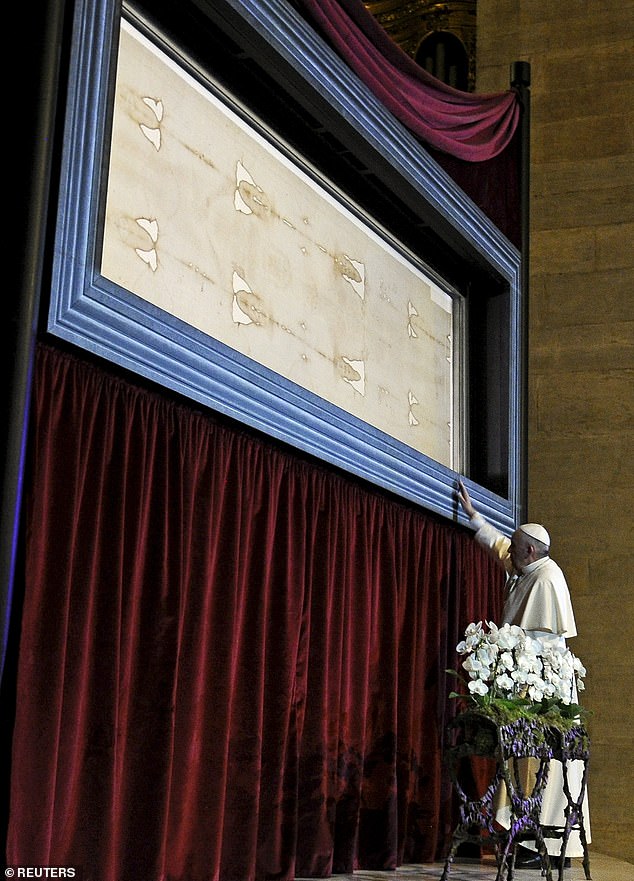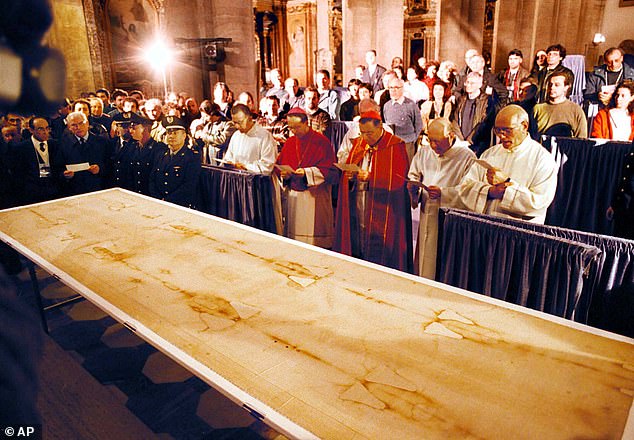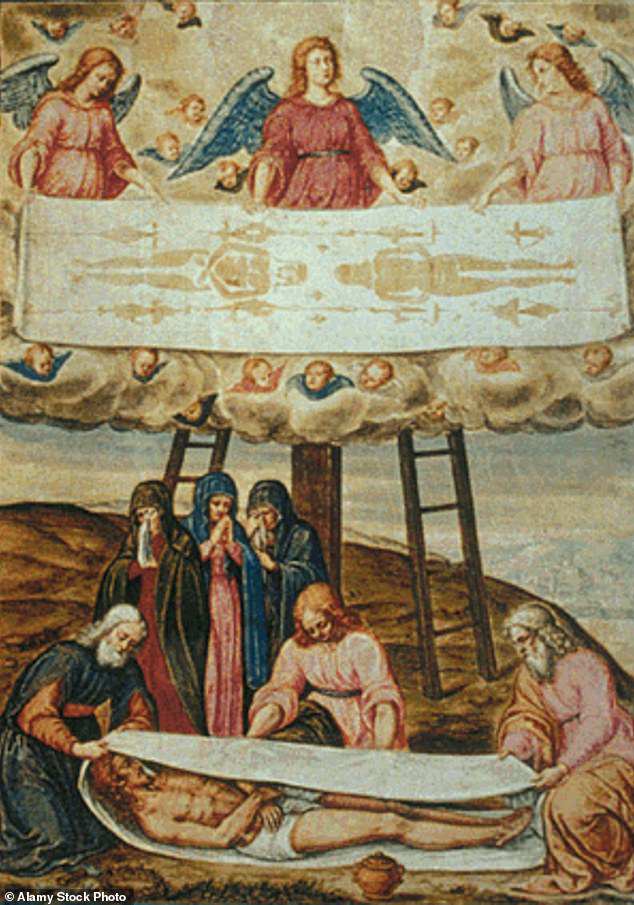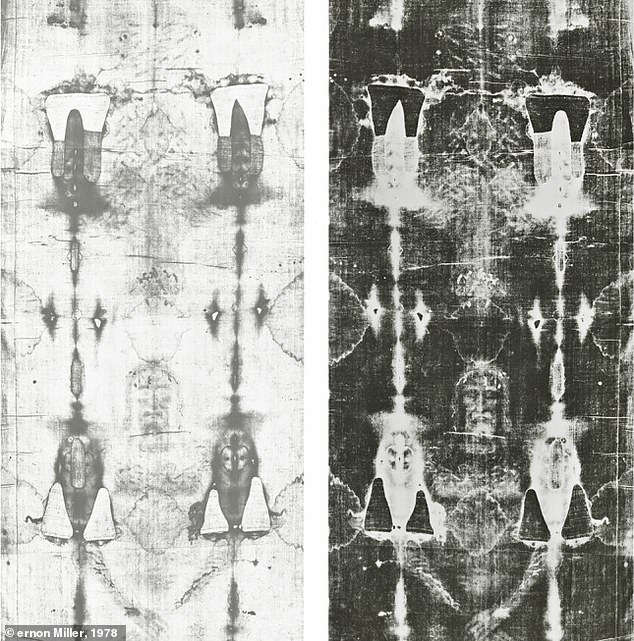The Shroud of Turin IS the cloth Jesus was buried in, scientist claims – and says he has ‘enormous amount of evidence’ to prove it
For centuries, Catholics have flocked to the Italian city of Turin to witness the famous shroud ceremony.
The venerated piece of linen, which measures 1.5 by 1.5 inches, features a faint image of the front and back of a man – interpreted by many as Jesus Christ.
Believers say it was used to wrap Christ’s body after his crucifixion, leaving his bloody imprint, like a photographic snapshot.
Despite repeated ‘hoax’ claims, a scientist is now convinced the object actually enveloped Jesus – and says there is a ‘huge amount of evidence’ to prove it.
Professor Liberato De Caro, a devout Catholic and deacon in his local church, debunked claims that it was produced in the Middle Ages with his recent research.
The Shroud of Turin shows the image of a man with sunken eyes, which experts analyzed under different filters to study it (photo)
Professor De Caro told the TelegraphIf I were to be a judge in a trial and weigh all the evidence that says the Shroud is authentic and the little evidence that says it is not, I could not in good conscience declare that the Shroud of Turin is medieval.
“It wouldn’t be right, given the enormous amount of evidence for it.”
Professor Liberato De Caro recent X-ray examination in which the Shroud of Turin was found, indeed dates from 2,000 years ago – around the time Christ lived and died.
We also know from the Shroud of Turin Research Project (STURP) in the 1970s and 1980s that the sacred tissue was indeed stained with blood.
STURP discovered that the spots contained traces of hemoglobin – the protein in red blood cells that supplies oxygen.
The stains also gave a positive test for serum albumin, the most abundant human blood protein in blood plasma.
In 1981, STURP wrote in its final report: ‘We can provisionally conclude that the Shroud image is that of a real human form of a scourged, crucified man.
“It’s not the product of an artist.”
So until his new research ‘the only missing piece of the puzzle was dating’, Professor De Caro told MailOnline.
He said everything on the shroud “is very much related to what the Gospels tell about Jesus Christ” and his death.
The canvas appears to have faint, brownish images on the front and back, depicting a thin, sunken-eyed man who was about six to six feet tall.
Marks on the body also match Jesus’ crucifixion wounds mentioned in the Bible, including thorn marks on the head, cuts on the back and bruises on the shoulders.
Historians have suggested that the cross he carried on his shoulders weighed about 300 pounds, which would have left some bruises.
The Bible states that Jesus was beaten by the Romans, in line with the cuts on the back, who also placed a crown of thorns on his head before the crucifixion.

The shroud first appeared in France in 1354. After initially labeling it as fake, the Catholic Church has now embraced the shroud as real. In the photo, Pope Frances touches the Shroud of Turin during a visit in 2015

Many think the Shroud of Turin (pictured) is the cloth in which Jesus’ body was wrapped after his death, but not all experts are convinced it is real.
Research from the 1980s appeared to debunk the idea that it was real after dating it to the Middle Ages, hundreds of years after the death of Christ – suggesting it was an elaborate medieval hoax.
But the Italian academics, using a new technique involving X-rays, confirmed that the material was produced around the time of Jesus, some 2,000 years ago.
Professor De Caro and his team from the Institute of Crystallography of the National Research Council in Bari, Italy, used a technique called wide-angle X-ray scattering (WAXS) on a small sample of the shroud, smaller than a grain of rice.
WAXS can date ancient linen threads by ‘inspecting their structural degradation’ at the microscopic level.

The Bible says that Joseph of Arimathea wrapped Jesus’ body in a linen shroud and placed it in a new tomb

The scientists obtained small samples of the Shroud of Turin (left) and exposed them to wide-angle X-rays to create an image of the linen sample (right) used for the dating.
The analysis looked at the cellulose patterns of the linen, the long chains of linked sugar molecules.
These sugar molecules break down over time, indicating how long a garment or cloth has been around.
Based on the amount of defects, the team determined that the shroud was stored at a temperature of about 22.5 degrees Celsius and a relative humidity of about 55 percent for about 13 centuries before arriving in Europe.
If it had been stored under different conditions, the aging would have been different.
Researchers then compared the breakdown of cellulose in the shroud to other linens found in Israel dating back to the first century.
They concluded that the structural degradations were “fully compatible” with those of the other linen sample – which historical records date to 55-74 AD.
The team also compared the shroud to samples of linen made between 1260 and 1390 AD, and found that none were a match.

Some suggest that the bloodstains on the shroud (shown in this negative image) are clear evidence that the cloth was used to wrap an injured person
The new findings confirm the idea that the faint, blood-stained pattern of a man with his arms folded forward was left behind by Jesus’ dead body.
They also contradict findings from the 1980s that the shroud does not date back nearly as far as the time of Jesus.
At the time, researchers analyzed a small piece of the shroud using carbon dating and determined that the cloth appeared to have been made sometime between 1260 and 1390, during the Middle Ages.
However, the authors of the new study argue that carbon dating would not have been reliable because the substance has been exposed over centuries to contamination that cannot be removed.
Furthermore, there is no way to explain how it could have been accomplished with medieval technology.
“While authenticity cannot be established, it should be fairly easy to determine whether it is a medieval forgery,” said Tim Andersen, a research scientist at the Georgia Institute of Technology, who was not involved in the new study.
‘Yet, despite decades of scientific testing and peer-reviewed articles on the subject, that conclusion has never been demonstrated.
“On the contrary, the evidence consistently points away from known counterfeiting techniques.”
